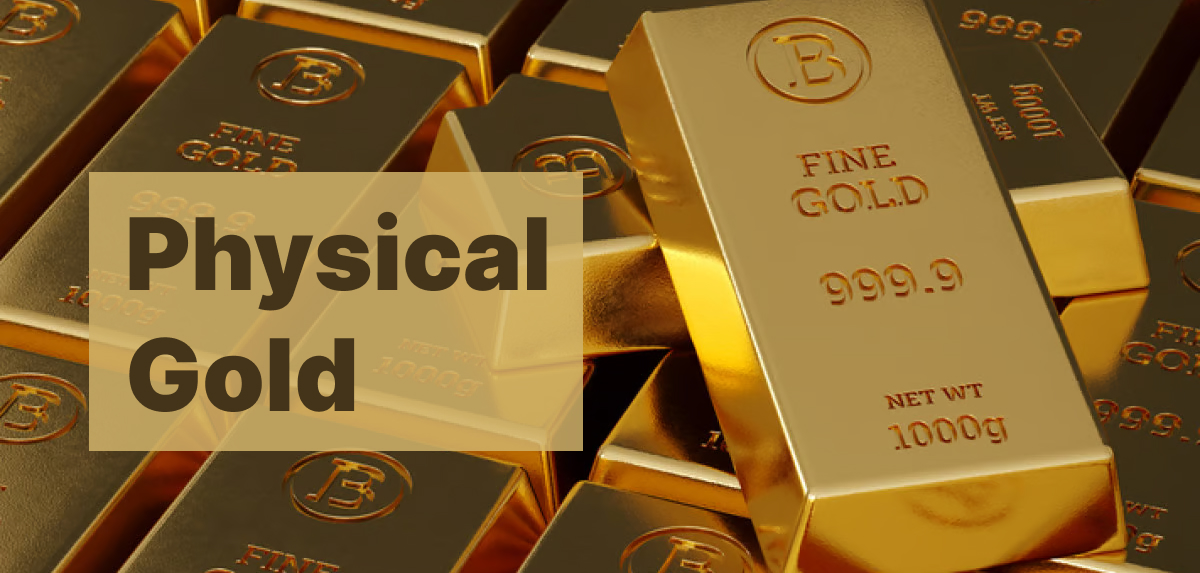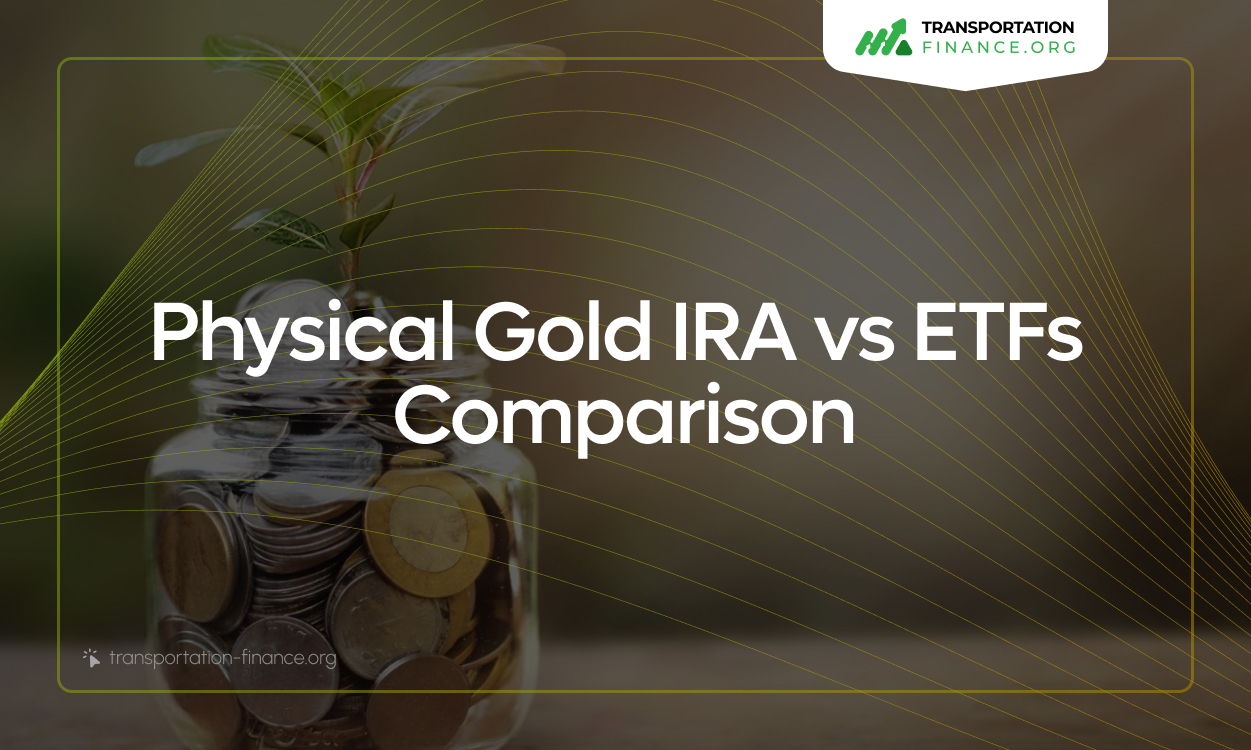Disclaimer: The companies mentioned in this report may offer compensation to us, without any charge to our readers. This is how we keep our reporting free for readers. Our selection of companies is determined by compensation and rigorous analysis.
Are you looking to understand the differences between a Physical Gold IRA and ETFs? This article is your comprehensive guide to navigating these two investment options.
We'll delve into the crucial distinctions, covering aspects such as ownership, liquidity, storage, and fees. You'll also discover the similarities between them, including their exposure to gold and growth potential.
Unsure which option aligns best with your investment goals and risk tolerance? We'll provide insightful tips to help you make an informed decision. Ready to dive in and make a well-informed choice? Let's begin.
Our team has spent years researching every company in the precious metals industry. Save your time and use our research ⟶
Hand picked top 5 trusted and best reviewed companies
Protect Your Retirement
Claim Your FREE Gold Kit Now
What Is A Physical Gold IRA?
You know, a Physical Gold IRA is a retirement account that lets you hold actual gold instead of just paper assets. It’s a chance to invest in gold bullion or coins while enjoying tax advantages through an IRA setup.
With this type of IRA, you get to mix things up in your portfolio by adding a physical asset like gold, which has a history of holding its value.

Unlike traditional IRAs that are heavy on stocks, bonds, or mutual funds, a Physical Gold IRA can serve as a safety net during economic downturns or times of inflation. Think about it – physical gold is something real that you can touch and keep safe, offering a level of security that paper assets just can’t match.
And let’s not forget about the tax perks of a Physical Gold IRA, like potentially deferring capital gains tax until you make withdrawals. It’s a smart move for anyone aiming to safeguard and grow their wealth in the long run.
What Are ETFs?
If you’re looking to dip your toes in the investing world, you might want to check out ETFs, also known as Exchange-Traded Funds.
These funds are like a mixtape of investments that you can trade on stock exchanges, giving you a taste of assets like gold without actually owning the stuff.Gold ETFs are especially popular for folks who want to add a bit of sparkle to their portfolios without dealing with physical gold.

With gold ETFs, you can either have a piece of the gold bars or invest in gold mining companies, letting you follow the ups and downs of gold prices.
The cool thing about gold ETFs is that you can buy or sell shares whenever you want during the trading day, giving you some flexibility in managing your investments. And here’s the cherry on top: gold ETFs are more cost-effective than buying and hoarding physical gold. They usually have lower expense ratios and save you from dishing out for storage and insurance costs.
What Are The Differences Between Physical Gold IRA And ETFs?
In terms of choosing between a Physical Gold IRA and Gold ETFs, you need to consider factors like ownership, liquidity, storage, fees, and tax benefits.
With a Physical Gold IRA, you get to own actual physical gold right there in your retirement account. It’s a tangible asset that’s safely kept in a custodian-approved facility. On the flip side, Gold ETFs give you a piece of the gold pie held by a fund, and you can trade them just like stocks – super easy to buy and sell.
Now, let’s talk storage. A Gold IRA means you’ve got to make sure that gold is securely kept, usually through a custodian. Gold ETFs, on the other hand, don’t have you stressing about where to stash your precious metal.
In terms of fees, Physical Gold IRAs come with custodial and storage charges, whereas Gold ETFs usually have lower expense ratios.
Then there’s taxes. Physical Gold IRAs can offer you some sweet tax perks like tax-deferred growth or even tax-free withdrawals under certain conditions. But gains from Gold ETFs might end up being hit with capital gains taxes.
Deciding between a Physical Gold IRA and Gold ETFs? Take into account your investment goals, how much risk you can handle, and your personal preferences before you make your move.
Protect Your Retirement
Claim Your FREE Gold Kit Now
1. Ownership
When you own a Physical Gold IRA, you get to have your hands on those actual physical gold assets right in your retirement account. It’s like having a secure, tangible piece of ownership that you can hold onto.
With this kind of ownership, you’re in control of your investment because you have a direct claim on the actual physical gold. It’s all about transparency and having the power to steer your investment in the right direction. Unlike Gold ETFs, where you’re holding shares in a fund that might not always be fully backed by physical gold, having physical gold in an IRA means you’re diversifying your portfolio with a real, valuable asset.
So, why go for it? Well, it’s a smart move for investors looking to hedge against inflation and economic uncertainties. Physical gold has a reputation for being a safe haven asset when the market gets all shaky. It’s like having a security blanket for your investment during those volatile times.
2. Liquidity
You get more liquidity with Gold ETFs compared to Physical Gold IRAs. With ETFs, you can buy and sell them on stock exchanges throughout the trading day.
This liquidity perk of Gold ETFs is super handy for you if you like having the flexibility to quickly jump in and out of positions. Unlike Physical Gold IRAs, where you have to deal with storing physical gold bars or coins, Gold ETFs offer an easier way to invest in gold without all the storage and security hassles.
Being able to trade Gold ETFs easily lets you respond fast to market changes and tweak your investment strategies as needed, giving you a level of nimbleness that traditional physical gold investments might not offer.
3. Storage And Insurance
If you’re thinking about setting up a Physical Gold IRA, you need a safe spot to stash that bling bling. Usually, that means finding an approved depository that meets IRS standards to keep your gold secure and sound.
When you’re choosing where to park your precious metal, go for storage facilities with top-notch security features. These places are like Fort Knox for your assets, protecting them from any funny business like theft, loss, or damage. Don’t forget about insurance coverage for your gold in storage – it’s like an extra security blanket for your shiny treasures.
Make sure to dig into the insurance policies offered by storage facilities and ensure you’ve got enough coverage to cover any unexpected mishaps. By taking care of storage and insurance details upfront, you’ll amp up the security and longevity of your Physical Gold IRA.
4. Fees
If you’re considering investing in a Physical Gold IRA, be aware that you might face higher fees related to storage, insurance, and trustee services compared to Gold ETFs. That’s because Gold ETFs often come with lower expense ratios and trading fees, making them a more cost-effective option for some individuals.
The fees tied to a Physical Gold IRA can vary depending on the custodian and the amount of gold you’re holding. These costs can add up over time, potentially affecting your overall returns. Expenses like insurance and secure storage facilities also play a role in the total cost of maintaining a Physical Gold IRA.
On the flip side, Gold ETFs usually have clearer fee structures. They typically disclose their expense ratios upfront, which are often lower than those of Physical Gold IRAs. Knowing these fee differences is essential for you to make informed decisions based on your long-term investment goals and risk tolerance levels.
5. Tax Benefits
If you’re considering your investment options, Physical Gold IRAs could be a smart move. They come with tax perks like potential tax deferral on gains and the chance to switch to a Roth IRA for tax-free withdrawals. On the other hand, Gold ETFs might bring along some tax implications tied to capital gains.
By going for a Physical Gold IRA, you could enjoy tax-deferred growth that shields you from immediate tax obligations while your investment grows. And if you decide to convert to a Roth IRA, you can make the most of tax-free withdrawals in your retirement years. On the flip side, investing in Gold ETFs means you could be on the hook for capital gains taxes, which could eat into the profitability of your gold investments.
Knowing the ins and outs of these tax-efficient strategies is key to crafting a solid financial plan that lines up with your long-term wealth-building goals.
What Are The Similarities Between Physical Gold IRA And ETFs?
In terms of investing in gold, you’ve got options like Physical Gold IRAs and Gold ETFs that can give you a piece of the golden pie. They both let you ride the waves of gold price changes and market ups and downs to potentially grow your wealth.
People like you are eyeing these choices to mix things up in their investment portfolios and shield themselves from market rollercoasters. Whether it’s a Physical Gold IRA or a Gold ETF, you can own gold directly or indirectly without having to worry about storing it at home.
This hassle-free setup, combined with the chance for your investment to grow, makes them pretty enticing for folks who want to keep their money safe in uncertain economic waters. And with both options, you can easily jump on board market trends by buying or selling gold positions whenever you see fit.
1. Exposure To Gold
If you’re looking to diversify your investment portfolio and dip your toes into the precious metals market, both Physical Gold IRAs and Gold ETFs can be your go-to options. They let you get a piece of the action in the gold market, which is like a superhero cape for your portfolio when things get rocky.
Gold has always been the go-to buddy during tough times in the financial world, keeping its value steady. By adding gold to your investment mix, you’re basically putting on a safety harness to handle risks and balance out potential losses in other investments.
With Physical Gold IRAs, you get to own actual gold bullion, like having a treasure chest of wealth right at your fingertips. On the flip side, Gold ETFs offer a more flexible and easy-to-trade route for those eyeing exposure to gold prices without the hassle of storing it physically. Both these options are key players in spreading out your investments and safeguarding your wealth in a solid investment mix.
2. Potential For Growth
You can tap into the potential for growth in gold prices by exploring two key options: Physical Gold IRAs and Gold ETFs. The returns you’ll see from these investments are directly affected by market conditions and how the gold market is performing.
Gold is a rockstar when it comes to having real value and being a safe bet during times of economic uncertainty and inflation. The worldwide demand for gold, fueled by things like political tensions, central bank strategies, and currency devaluation, really shapes how its price moves around. The fact that gold is in limited supply just adds to its appeal as a long-term investment.
By getting a handle on these factors and keeping up with market trends, you can confidently decide how to dive into the growth potential that gold investments offer.
Protect Your Retirement
Claim Your FREE Gold Kit Now
Which Is Better: Physical Gold IRA Or ETFs?
When deciding between a Physical Gold IRA and Gold ETFs, you need to consider factors like your investment timeline, commission costs, and whether you prefer owning physical assets.
A Physical Gold IRA gives you direct ownership of physical gold, offering a sense of security and control over tangible assets. On the flip side, Gold ETFs provide a more liquid and convenient way for investors to tap into gold prices without dealing with physical storage.
To pick the right option, think about your long-term investment goals and how much risk you’re comfortable with. Doing a comprehensive cost analysis and understanding the tax implications of each investment can also help you make smart decisions about where to put your money.
1. For Long-Term Investment
If you are considering long-term investment strategies, you might want to check out a Physical Gold IRA. With this option, you can own physical gold assets that could potentially bring in income over time. On the other hand, Gold ETFs offer a different route for those seeking passive gold exposure.
By going for a Physical Gold IRA, you get the security of holding actual gold assets that can act as a safety net against economic uncertainties. The flexibility of a Gold IRA also lets you diversify your retirement portfolio with a tangible asset that has a history of holding its value.
Alternatively, Gold ETFs provide the convenience of trading gold on stock exchanges without the hassle of physical storage. Each option caters to different investment preferences, offering ways to accumulate wealth in the long run amidst the ever-changing financial landscape.
2. For Short-Term Investment
If you’re looking to make quick moves in the gold market, Gold ETFs might be your jam. They offer liquidity and trading flexibility, giving you easy access to gold price shifts and a way to capitalize on market conditions.
With Gold ETFs, you can trade gold without dealing with the hassle of physical ownership. It’s a cost-effective and efficient way to get in on the precious metal action. Plus, being able to buy and sell Gold ETFs on major stock exchanges means you’ve got great liquidity. That way, you can jump in and out of positions swiftly when the market does its thing.
Watch factors like gold price swings and global economic trends – they can have a big impact on how Gold ETFs perform for short-term investing.
3. For Tax Benefits
If you’re someone who’s all about tax efficiency and planning for retirement, you might want to consider going for a Physical Gold IRA. This option comes with some neat tax advantages like potential tax deferral on gains and strategic estate planning perks. On the flip side, Gold ETFs could have some tax implications tied to trustee fees and taxable gains.
If you’re someone who’s all about tax efficiency and planning for retirement, you might want to consider going for a Physical Gold IRA. This option comes with some neat tax advantages like potential tax deferral on gains and strategic estate planning perks. On the flip side, Gold ETFs could have some tax implications tied to trustee fees and taxable gains.

When you’re laser-focused on tax benefits in your investment choices, you’ll know that a Physical Gold IRA can be a game-changer for your long-term wealth goals. With this setup, you could delay paying taxes on any profits you make from your gold investments, giving your savings room to grow without getting hit with immediate tax bills.
But if you decide to dive into Gold ETFs instead, be ready for some potential downsides like trustee fees and taxable gains. These factors could eat into your overall investment returns and throw a curveball into your retirement planning strategies.
4. For Diversification
In terms of diversifying your investment portfolio, both Physical Gold IRAs and Gold ETFs are solid options to consider. They give you a way to dip your toes into the gold market and mix things up with your other asset classes, like mutual funds, for a well-rounded investment strategy.
Gold is like that cool, reliable friend you have in the world of investments. It acts as a hedge against economic uncertainties and inflation, helping to balance out your risk. Adding gold to your mix can help smooth out the ups and downs and potentially boost your long-term returns.
Physical Gold IRAs let you have actual gold in your hands, giving you that extra sense of security and a safe haven when the market gets rocky. On the flip side, Gold ETFs offer a hassle-free way to invest in gold without the fuss of physical ownership. They’re all about convenience, liquidity, and flexibility for savvy investors like you.
How To Decide Between Physical Gold IRA And ETFs?
When deciding between a Physical Gold IRA and Gold ETFs, you need to think carefully about your investment goals, how much risk you’re comfortable with, compare fees, and talk to a financial advisor to make sure your investment strategies match your financial goals.
You’ve got to figure out your long-term investment goals to see which option fits best in your portfolio. A Physical Gold IRA gives you actual ownership of physical gold, which can make you feel secure during uncertain economic times. On the other hand, Gold ETFs offer a more liquid and easy-to-trade investment choice.
It’s important to understand the tax implications, storage needs, and management fees that come with each option before making a decision. Getting advice from a qualified financial professional can give you valuable insights and make it easier to navigate the complexities of these investment options.
1. Consider Your Investment Goals
You need to assess your investment goals and figure out what you’re after – long-term wealth preservation with a Physical Gold IRA or short-term trading opportunities with Gold ETFs. Make sure your strategies match your risk tolerance and leverage preferences.
Understanding how long you plan to invest is key when choosing between Physical Gold IRAs and Gold ETFs. If you’re in it for the long haul and want sustained growth over decades, a Physical Gold IRA might be your best bet, acting as a shield against inflation and market uncertainties.

On the flip side, if you’re aiming to cash in on short-term price swings, Gold ETFs can give you more liquidity. Think about how much leverage you’re comfortable with and put in place risk management tactics to customize your approach and meet your specific investment goals.
2. Evaluate Your Risk Tolerance
When deciding between a Physical Gold IRA and Gold ETFs, think about your risk tolerance. Gold ETFs might come with trading fees and leverage that could affect short-term volatility and risk exposure in your investment portfolio.
You need to understand your risk tolerance to figure out how okay you are with potential ups and downs in your investments. While Gold ETFs are easy to trade and offer liquidity, they also bring their own set of risks.
Trading fees can nibble away at your returns, especially if you’re frequently buying and selling. Plus, leverage in Gold ETFs can crank up both your gains and losses, making them more unpredictable. This extra unpredictability might not sit well with investors who are after stable, long-term returns.
3. Research And Compare Fees And Expenses
Before you decide between a Physical Gold IRA and Gold ETFs, make sure to do your homework. Compare the fees, expenses, and expense ratios of each investment option. Take a look at the current market conditions and think about how they could affect the long-term performance of your investment.
When you understand how the fees and expense ratios work for Physical Gold IRAs and Gold ETFs, you’ll be able to make smart choices that match your financial goals. Market conditions are key in figuring out the cost-effectiveness of these investments.
With gold prices fluctuating, expense ratios can change and have an impact on your investment returns over time. So, it’s a good idea to weigh these factors alongside your investment strategy to get a clear picture of whether a Physical Gold IRA or Gold ETF is the right fit for you.
4. Consult A Financial Advisor
When deciding between a Physical Gold IRA and Gold ETFs, you should seek advice from a financial advisor. They can help you evaluate performance expectations, investment strategies, and see how they align with your overall investment plan and financial goals.
Financial professionals are like your guides in the investment jungle, especially when choosing between options like Physical Gold IRAs and Gold ETFs. They can give you the lowdown on risk management, potential returns, and even the tax implications that come with these investments.
By tapping into their wisdom, you can make smart decisions, fine-tune your investment strategy for long-term success, and ensure that your portfolio matches your financial objectives. Getting advice from a financial advisor ensures that your investment choices are well-informed, strategic, and tailored to your unique financial situation.
Protect Your Retirement
Claim Your FREE Gold Kit Now

I’m Bob Smithfield, your guide to making smart, safe investments. Here, I share financial insights and strategies that help you navigate the complex world of finance with confidence.
My goal is to provide you with the information and tools you need to make informed decisions about your finances.
